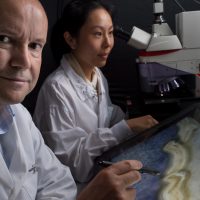Imagine killing cancer through a small needle without surgery or restoring blood flow to critical organs or limbs. It’s quite likely that this is all in a day’s work for interventional radiologist Dr. Stephen Ho and his team at VGH thanks to a new angiography suite funded by the generosity of philanthropic leaders Sonny and Florence Leong.
The Leongs have a long history of being involved in the health care field – Sonny was a pharmacist, Florence was a nurse, and they have many family members who are in the medical profession. It’s no surprise that their donation is centered on giving back to the community of patient care. “To us, giving back to society is the right thing to do, especially to health care,” says Sonny. “Canada has treated us very well and has given us many opportunities – we can all contribute.”
Angiography is an advanced x-ray system that takes exceptional anatomical images. The Leongs’ donation includes the purchase of a special, highly complex piece of equipment for the renovated angiography suite that will put the latest technology upgrades into the skilled hands of specialists and ensure that British Columbians suffering from stroke, vascular disease, aneurysms, cancer and other complex conditions receive the best health care possible.

The renovated angiography suite at VGH will provide improved patient outcomes.
New imaging technology and interventional devices over the past 20 years has greatly increased the number of medical conditions that may now be treated using interventional radiology. Traditionally, interventional radiology has been performed through a puncture through the groin. Recovery meant lying flat for several hours, an inconvenient and sometimes uncomfortable process for patients. Advances in technology will now allow many of these procedures to be performed through a puncture in the wrist. Recovery time is much shorter and more comfortable.
Today, many conditions that once required surgery can be treated non-surgically by interventional radiologists like Dr. Ho. Interventional radiology uses the body’s natural pathways – the arteries and veins – to thread catheters to an area anywhere in the body that is diseased, including cancers that cannot be removed surgically. It’s a remarkable, minimally invasive procedure that allows patients to return to their lives with very little interruption.
“The new angiography suite means we’re equipped for greater precision and improved patient outcomes,” says Dr. Ho. “And now that we’re getting close to building our new suite, we’ve had interest from medical institutions around the world wanting to come here to learn about our work. It’s a fantastic opportunity to continue to showcase the outstanding work that we do.”

